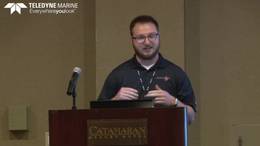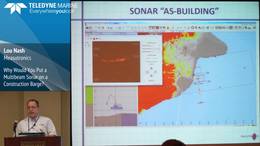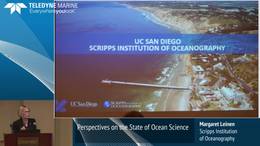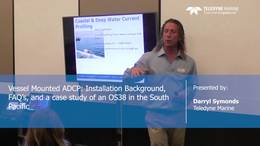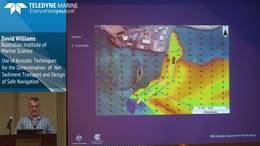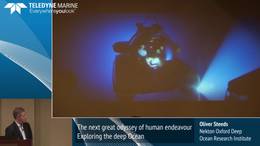Seasonal to Decadal Variability in the Upper Ocean Scattering Layer in Drake Passage
The surface shoaling of nutrient-rich waters poleward across the Antarctic Circumpolar Current is responsible for the elevated productivity of the Southern Ocean. Over the last half century, the Southern Ocean has been warming at a faster rate than the global ocean as a whole. In particular, the Antarctic Peninsula region has undergone rapid atmospheric warming, significant glacial retreat and a decrease in seasonal sea ice extent, impacting krill and its predators. Improving knowledge of the Southern Ocean is a high priority for understanding the effects of climate change, but the harsh environment poses substantial observational challenges.
The U.S. Antarctic Research and Supply Vessel Laurence M. Gould crosses Drake Passage 2-4 times per month in all seasons, collecting underway data on transits between Punta Arenas, Chile and Palmer Station, Antarctica. High-resolution measurements of upper ocean temperature, salinity, velocity and acoustic backscatter, along with concurrent meteorological, surface water CO2 and nutrient measurements have been routinely acquired since the late 1990s. This study makes use of 238 acoustic Doppler current profiler (ADCP) transects collected over a 12-year period to remotely sense the characteristics of the near-surface scattering layer, which at 153.6 kHz is dominated by macrozooplankton. Although the primary use of the shipboard ADCP is to measure ocean currents, the measured acoustic backscatter has provided valuable insights into the depth distributions, vertical migration behaviors and even life cycles of dominant biological scatterers. Diel vertical migration and a well defined annual cycle are observed, consistent with krill behavior. Significant geographic variations are present on both seasonal and interannual time scales. Interannual variability is linked to two main climate modes, the El Niño-Southern Oscillation and the Southern Annular Mode, as well as to variations in seasonal sea ice extent. Limitations of the present study and proposed sampling to address them will also be discussed.
Presented by:
Dr. Teresa K. Chereskin
Scripps Institution of Oceanography at the University of California, San Diego
The U.S. Antarctic Research and Supply Vessel Laurence M. Gould crosses Drake Passage 2-4 times per month in all seasons, collecting underway data on transits between Punta Arenas, Chile and Palmer Station, Antarctica. High-resolution measurements of upper ocean temperature, salinity, velocity and acoustic backscatter, along with concurrent meteorological, surface water CO2 and nutrient measurements have been routinely acquired since the late 1990s. This study makes use of 238 acoustic Doppler current profiler (ADCP) transects collected over a 12-year period to remotely sense the characteristics of the near-surface scattering layer, which at 153.6 kHz is dominated by macrozooplankton. Although the primary use of the shipboard ADCP is to measure ocean currents, the measured acoustic backscatter has provided valuable insights into the depth distributions, vertical migration behaviors and even life cycles of dominant biological scatterers. Diel vertical migration and a well defined annual cycle are observed, consistent with krill behavior. Significant geographic variations are present on both seasonal and interannual time scales. Interannual variability is linked to two main climate modes, the El Niño-Southern Oscillation and the Southern Annular Mode, as well as to variations in seasonal sea ice extent. Limitations of the present study and proposed sampling to address them will also be discussed.
Presented by:
Dr. Teresa K. Chereskin
Scripps Institution of Oceanography at the University of California, San Diego

